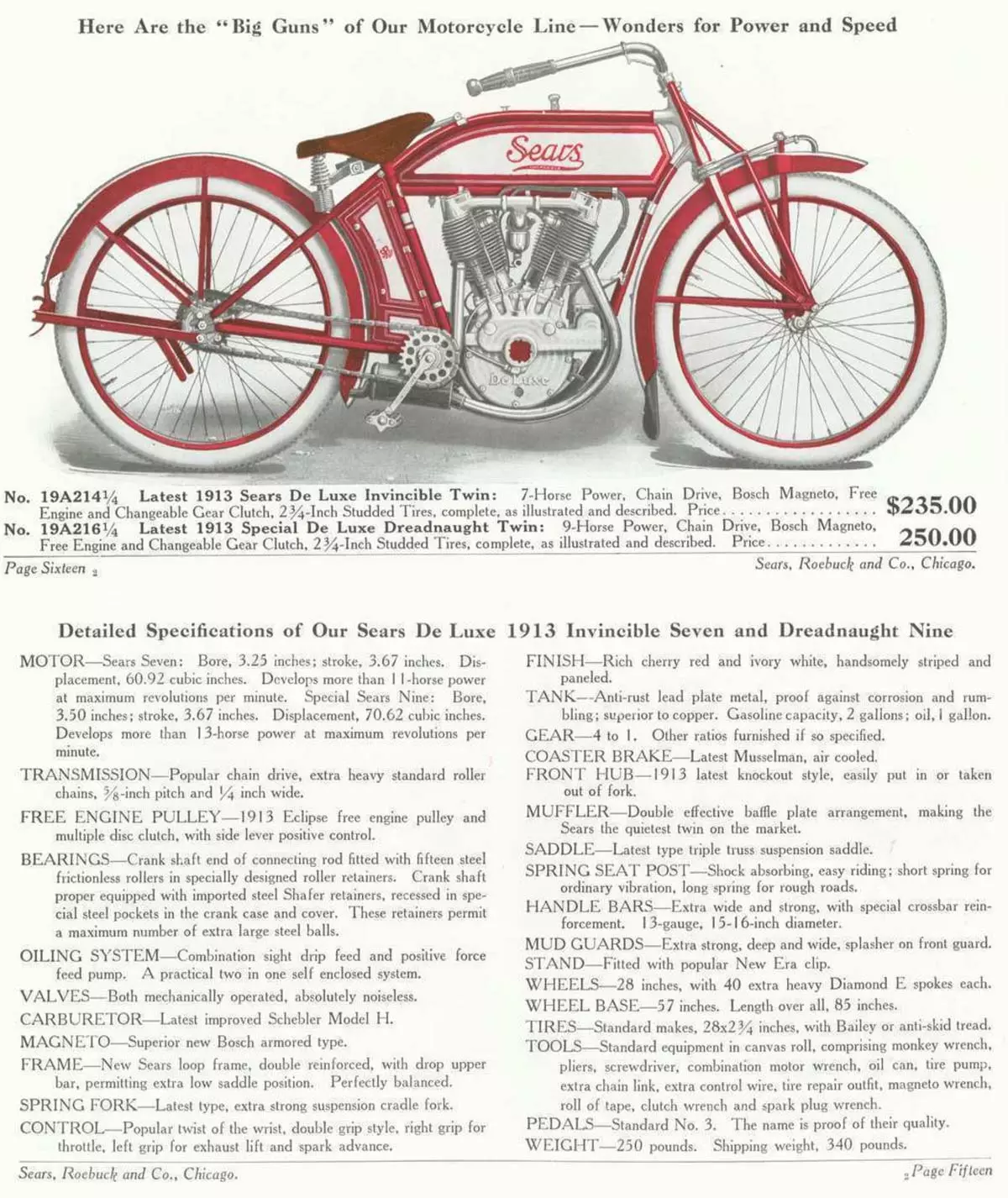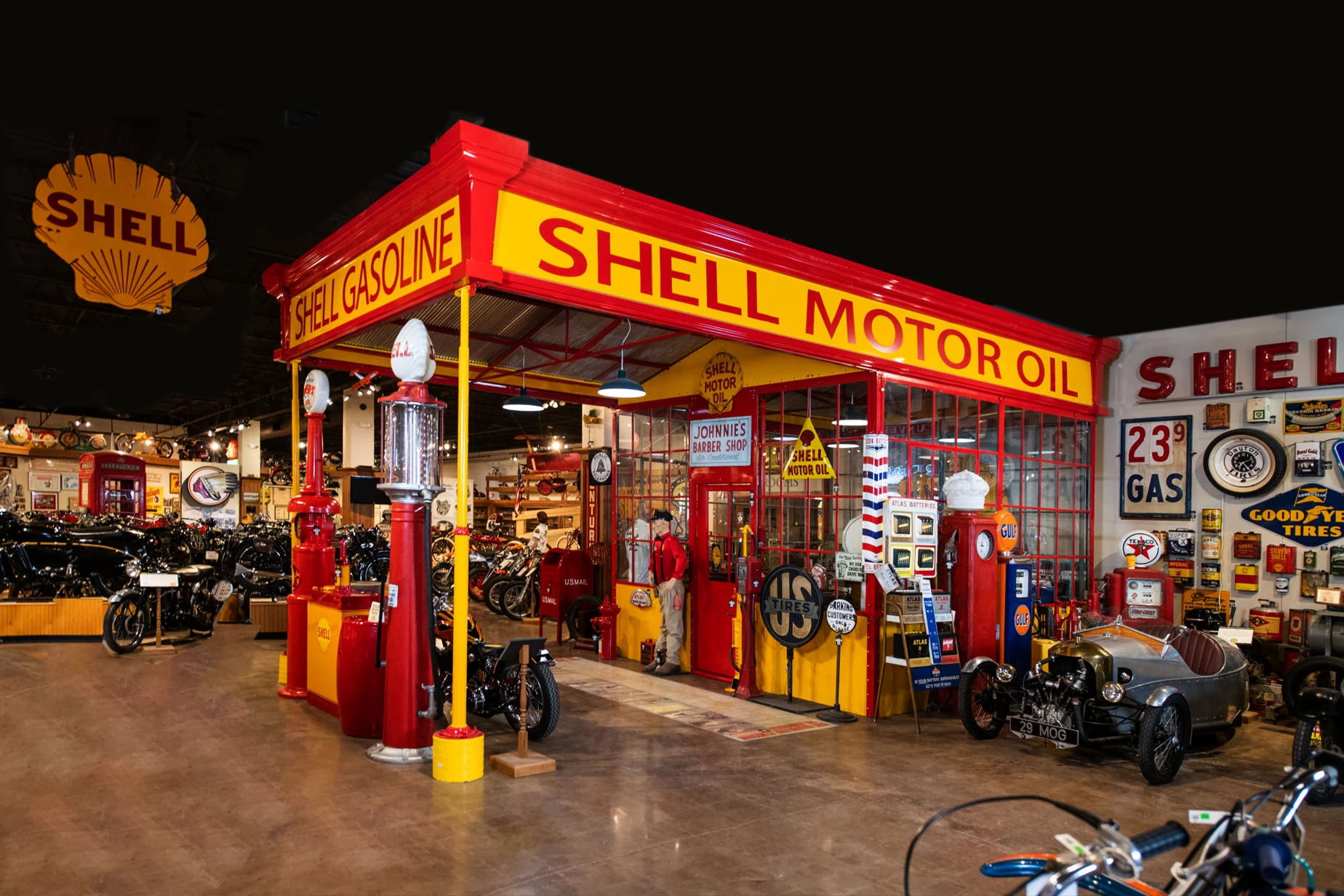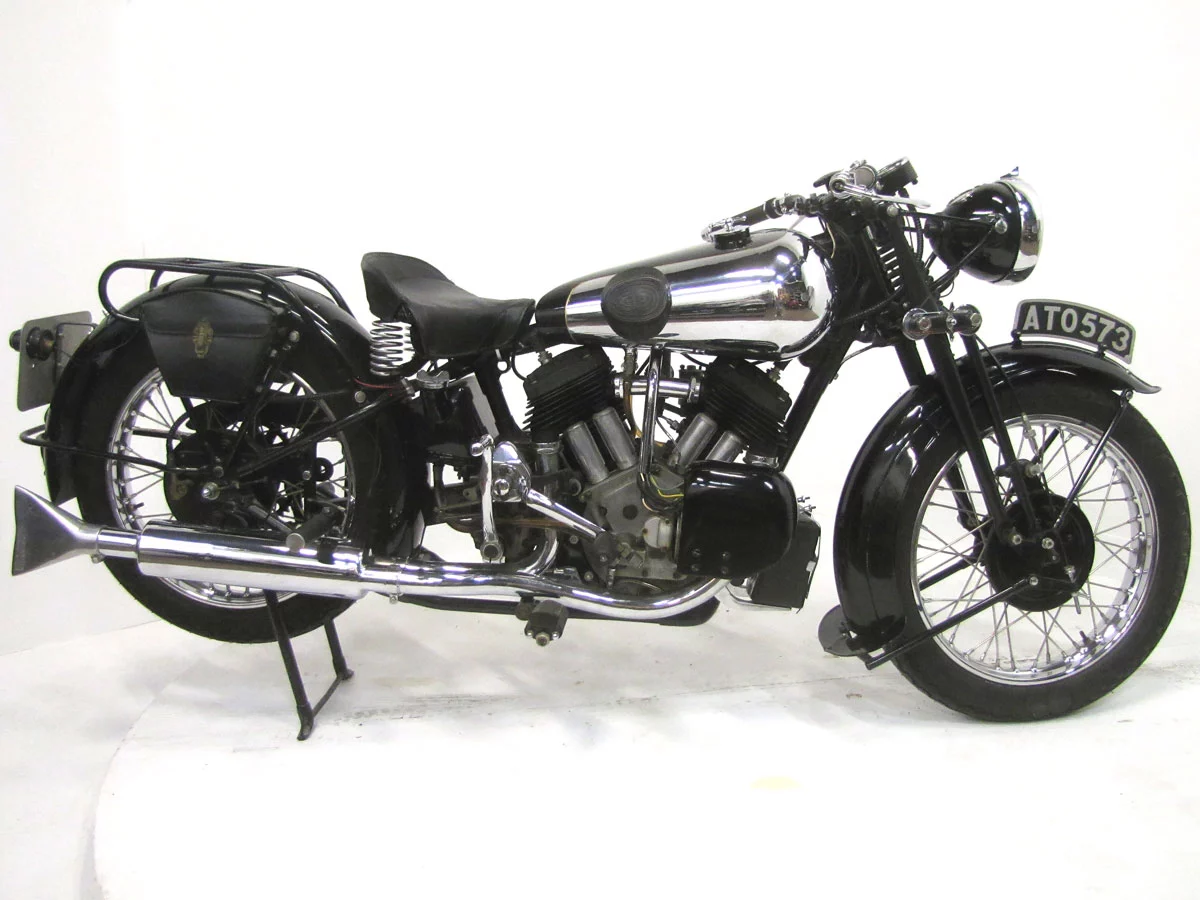The sale of the John Parham Motorcycle Collection this week didn’t receive much coverage in the motorcycle media, perhaps because it wasn't widely recognized that Parham was essentially the National Motorcycle Museum. When a museum collection goes to auction there are always historically significant artifacts on offer, and in this case the sheer volume of high quality lots combined with a non-mainstream location meant that some serious bargains were snaffled.
Parham was the driving force behind the National Motorcycle Museum in Iowa. Following his death, his 300-plus motorcycle collection which formed the core of the museum display, was sold off by Mecum Auctions “in situ” and it contained so many of history’s most important motorcycles that it offered something for everyone, regardless of their two-wheeled interests.
From board trackers to dirt trackers to road racers to plain old transportation, the depth and breadth of the Parham Collection was vast, and it also contained significant machines from the bicycle and aviation industries which ran in close parallel to the motorcycle industry for several decades.
From an historic perspective, several of the motorcycles sold were unicorn rare, so this sale might one day be seen as one of the history’s most significant motorcycle auctions, along with the original Steve McQueen Estate Auction in 1984, the Otis Chandler Estate Auction in 2006 and the EJ Cole Collection Auction in 2015.
V-twin Heaven
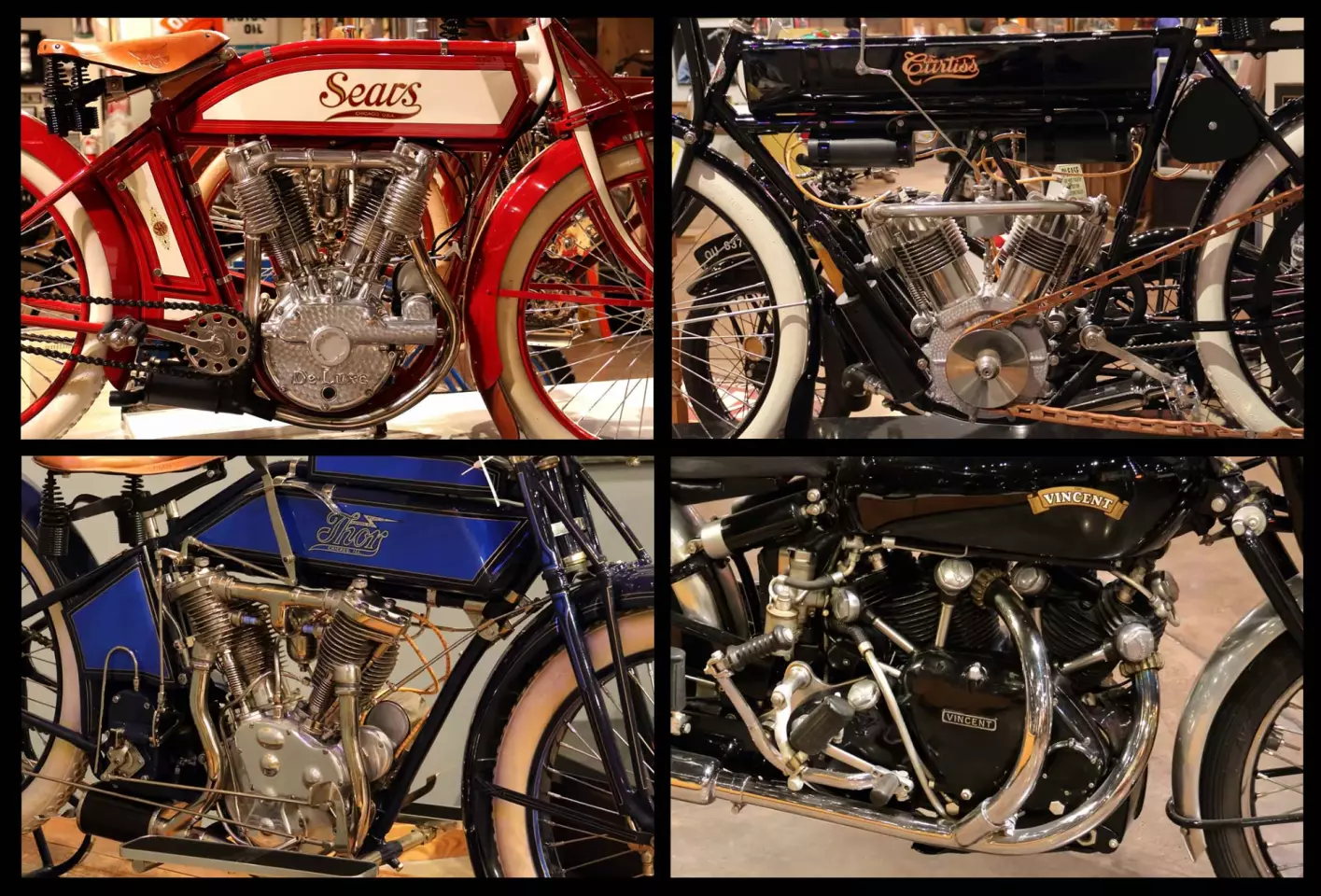
An eccentric firing order is as American as apple pie, rock 'n' roll and blue jeans. Throughout the last century, America embraced both the v-twin for its motorcycles and the V8 for its automobiles, and this auction had the finest examples of almost every significant v-twin in history, with specimens of every major American v-twin except for a Cyclone and a Crocker, and in most cases it offered multiple examples of the finest models. Indian made its first V-twin in 1905, Flying Merkel in 1908 and Harley-Davidson made its first V-twin engine in 1909, but the grandaddy of them all was included in this sale, made by one of the foremost engineering prodigies of the modern era. That's the Curtiss V-twin at top right above.
While the Curtiss is one of the most important motorcycles in the country, the 1150cc Sears Dreadnaught at top left in the above image is also an extremely rare model that just 22 years ago was the most valuable motorcycle that had ever been sold at auction.
On 15 September 2001, Sotheby's Motorcycles and Bicycles Auction in Chicago sold an exceptional unrestored 1914 Sears Dreadnaught Nine for US$126,750, the same day it sold Bruno Spaggiari's Ducati 750SS race bike (the bike that finished second in the legendary 1972 Imola 200 Ducati 1-2) for $121,250. They were the first two motorcycles to sell for more than $100,000 at auction.
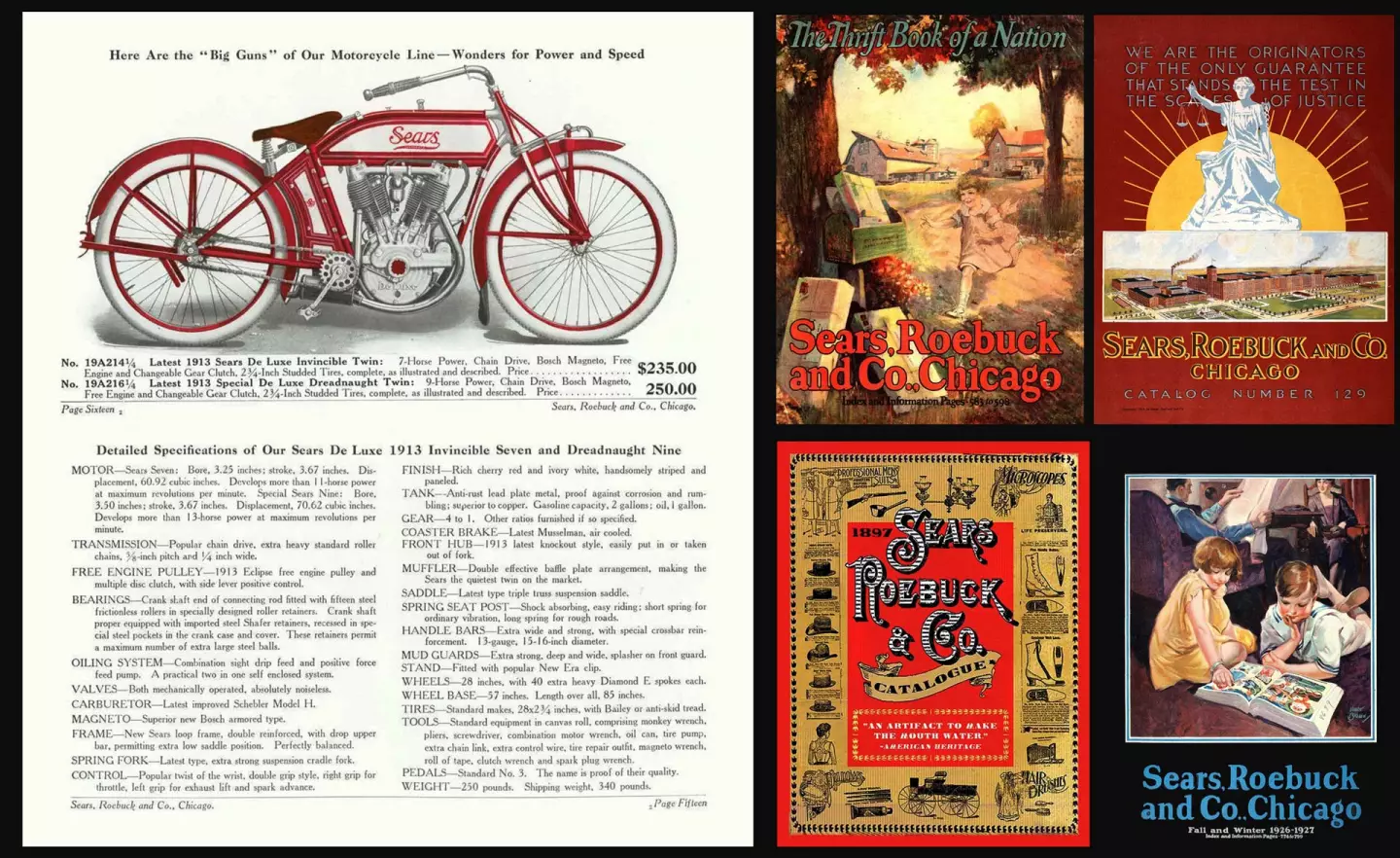
A near perfect specimen of that same motorcycle, a mail order motorcycle sold exclusively from the Sears & Roebuck catalogue, sold for $110,000 at this sale but it still hasn't matched that 2001 price of what was once the most valuable motorcycle in history, and there is no longer a Sears Dreadnaught in the top 100 motorcycles ever sold at auction.
Where possible, we've included both the link to the Mecum auction page and the relevant page on the museum web site, which is expected to only be available for a limited time. We've also limited the coverage to the most significant lots, and there are many more results that motorcycle collectors will find important and meaningful.
1927 Brough Superior SS100 Pendine Replica

Final price (inc Buyers Premium): $220,000
Estimate: $250,000 - $300,000
Auction Date: Saturday 9 September 2023
National Motorcycle Museum Link
Auction Page Link
Brough Superior is arguably the finest motorcycle marque to have ever existed, and the Pendine is the fastest, rarest and most desirable of all Brough Superior models. The Brough Superior SS100 model was the fastest production motorcycle in the world during the "Roaring Twenties", and with a catchy name and unsurpassed quality, the marque became an icon for excellence during a period of massive technological progress (cars, telephones, films, radio, recorded music and electrical appliances). The SS100 was guaranteed to have been tested and timed at over 100mph, while the Pendine was the racing version of the SS100, with each machine guaranteed to have been tested at over 110 mph.
Now Pendines are beyond rare. They almost never appear at auction because they are closely held by people who love the marque and don't care what they're worth because they're gonna die with them, and less than ten are still thought to exist. So this bike is a genuine Brough Superior SS100, built to replicate a Pendine, and with this sale it actually surpassed the price record for a Pendine at auction. Actually, the last time a complete Pendine came to auction was at least two decades ago because we can't find one. The last Pendine, of sorts, to sell at auction was a 1927 Brough Superior 981cc SS100 Pendine that was built from a genuine Pendine engine with the remainder of the bike assembled from a mixture of parts, including a replacement frame. It sold for £166,750 ($219,312) at Bonhams' 2018 Autumn Stafford Sale (our report here), so this bike claims some sort of record because it too is just a replica, but ... an exquisite replica.
1906 Curtiss Twin - the very first American V-twin
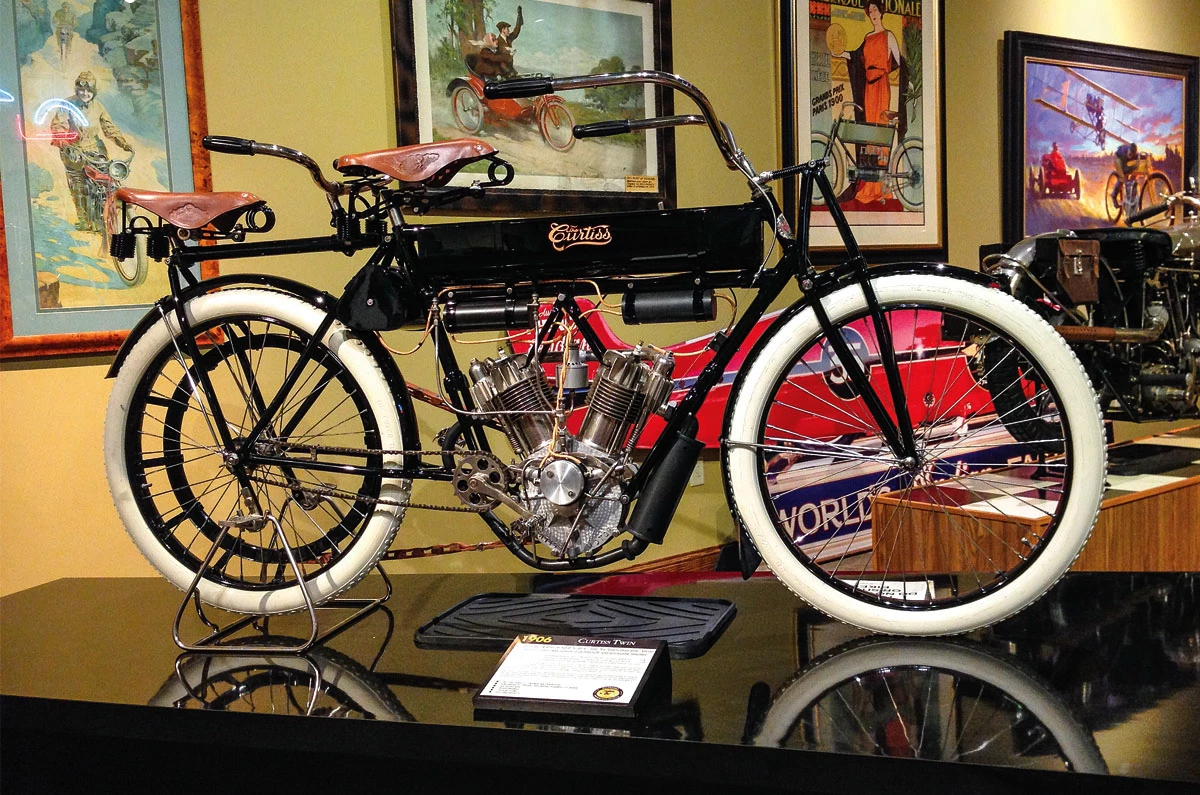
Final price (inc Buyers Premium): $214,500
Estimate: $100,000 - $120,000
Auction Date: Saturday 9 September 2023
National Motorcycle Museum Link
Auction Page Link
Glenn H Curtiss was one of the great aviation pioneers, partnering with the Wright Brothers to become one of the Captains of American industry, but he got his start building motorcycles, and the 1000cc Hercules was his first commercial success. Curtiss' first evident superpower (of many) was his ability to manufacture engines that were both powerful and reliable, and after building his first motorcycle in 1899 using a single cylinder Auto-Bi engine, he built his first 500cc single cylinder engine in 1901 and his first V-twin 1000cc in 1903, using it to set several land speed records, and going on to set a world land speed record (for any form of vehicle) at 136.27 mph on a V8-engined motorcycle of his own construction in 1906. It was the only time that a motorcycle has ever held the outright land speed record.

In addition to those data points captured in the above chart, there were at least two other Curtiss records between the initial 1903 speed of 64 mph (103 km/h) and the 1907 speed of 136.27 mph. This article by the curator of the Glenn H. Curtiss Museum, Rick Leisenring, cites him winning a 10 mile race on a 1000cc Curtiss in 1904 in 8 minutes and 54 seconds (an average speed of 67.4 mph) on a 1000cc V-twin and on the day prior (23 January 1907) to his 136.27 mph record, he used a stock 1000cc Curtiss to clock 46.67 seconds for a mile (an average 77.15 mph). That stock machine is the same model as this bike and hence the Curtiss motorcycle that sold at this auction is not just rare, but it is a landmark motorcycle because it is the same model that once held the world motorcycle speed record.
In our opinion, it is the direct association with Glenn Hammond Curtiss which gives this bike its greatest significance. Curtiss is a person of such historical gravitas, he is considered the father of naval aviation, one of the first and most credible aviators, the holder of the land and air speed records and countless other achievements. Curtiss was inducted into the AMA Motorcycling Hall of Fame in 1998 and is probably best known in motorcycling for his creation of an air-cooled V8 motorcycle which set a land speed record of 218 kph (136 mph) during the Florida Speed Carnival at Ormond Beach in January 1907.

The original machine is now in the Smithsonian, and a replica is on display at the Curtiss Museum in his hometown of Hammondsport.
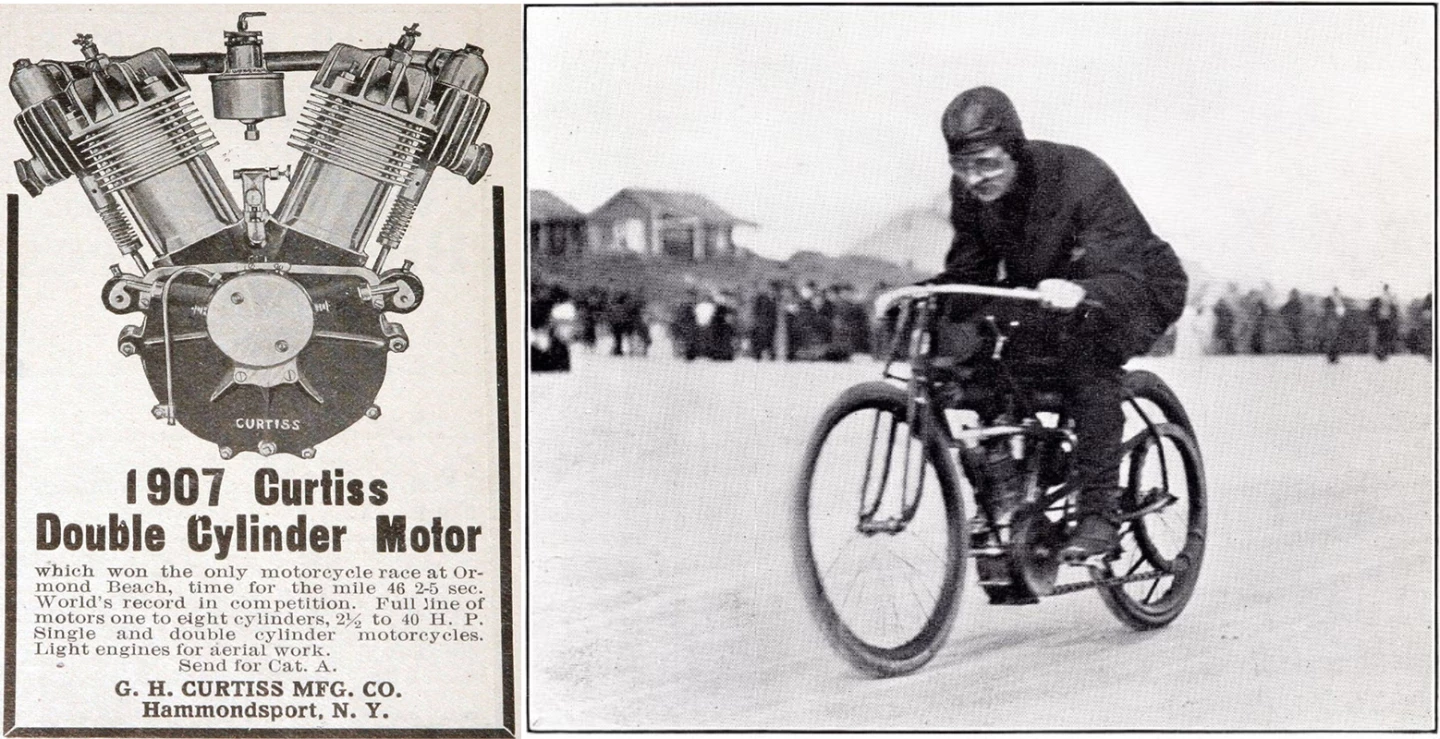
Curtiss' career was in its very infancy when he produced motorcycles, and they were produced in their entirety in the back room of his motorcycle shop - there was no factory as such. The total number of motorcycles built by Curtiss is unknown but however many there were to begin with, there are a lot less now. Only two have ever been to auction that we can find. The first was in 2006 when the collection of publishing magnate Otis Chandler was sold. There were two Curtiss motorcycles in the Otis Chandler Collection, being this bike, which sold for $132,000, and a 500cc single that sold for $110,000.
The only other Curtiss V-twin that has been to auction in the last 20 years was a barnfind that sold for $214,000 (with buyers premium) by MidAmerica auctions (now Mecum) in October 2009. The Vintagent's Paul D'Orleans was at that auction and wrote the story. As such, by a margin of just $500, the Curtiss Hercules 1000 just claimed a model and marque record - an incredibly modest total considering it is one of the rarest and most significant motorcycles in American history.
1920s Shell Service Station

Final price (inc Buyers Premium): $188,800
Estimate: $100,000 - $120,000
Auction Date: Saturday 9 September 2023
National Motorcycle Museum Link
Auction Page Link
In the 1920s, service stations were a growth business as petroleum-powered transport began to proliferate across America. In order to have consistently-branded service stations, Shell Oil Company produced flat-packed pop-up service stations that could be quickly assembled on a suitably prepared slab of concrete and this is one of the very few, perhaps the last remaining example of an entire service station from a century ago. This restored relic fetched far more than expected at $188,800.
1916 Thor Model U

Final price (inc Buyers Premium): $121,000
Estimate: $100,000 - $120,000
Auction Date: Saturday 9 September 2023
National Motorcycle Museum Link
Auction Page Link
Aurora Machine and Tool Company was a massive engineering company that built Indian’s first engines before designing and building their own complete motorcycles. Even as the company's Thor brand of motorcycle became a respected competitor in the marketplace, it still supplied castings and other components to brands such as Flying Merkel, Reading Standard, Henderson and Harley-Davidson. This 1916 1000cc V-twin represents the pinnacle of Thor motorcycle offerings and appropriately set a record price for both the marque and the model in this sale.
1933 Brough Superior 11/50

Final price (inc Buyers Premium): $115,500
Estimate: $80,000 - $96,000
Auction Date: Saturday 9 September 2023
National Motorcycle Museum Link
Auction Page Link
Launched in 1933, the 1,096 cc sidevalve 11-50 was the largest capacity Brough Superior to enter series production, sitting between the SS80 touring and SS100 super-sports models. The 11-50 was a long-legged, effortless tourer and could exceed 90 mph (145 km/h) in solo form or pull a heavy sidecar at up to 75 mph (120 km/h). Production lasted until 1939, by which time the 11-50 was the only JAP-powered machine in the Brough Superior range. The world record price for an 11-50 was set by a display bike from the Brough Superior stand at what was then the most important motorcycle show in the world, the 1937 Earls Court Motorcycle Show. Bonhams' 2015 Spring Stafford Sale was the venue and the bike fetched GBP £147,100 (US$223,364).
Mail-order superbike - 1913 Sears Dreadnaught Nine

Final price (inc Buyers Premium): $110,000
Estimate: $45,000 - $54,000
Auction Date: Saturday 9 September 2023
National Motorcycle Museum Link
Auction Page Link
The pinnacle of military technology in the first decade of the 20th Century was the British HMS Dreadnought, a massive heavily armoured battleship powered by steam turbines and with more firepower in one ship than had previously been imaginable. Instead of the small calibre armaments seen on prior war ships, the Dreadnought was to apply lethal force beyond the horizon, sporting five turrets, each with two 12-inch guns capable of sending 850-pound explosive shells 25 miles. Great Britain's naval power had given it the world's largest empire, and with war clouds on the horizon, its propaganda propelled the word "dreadnought" into everyday language on both sides of the Atlantic as a metaphor for overwhelming force. It was hence not surprising when Sears added an 1150cc motorcycle to its 1000 page mail order catalogue, that it should be called "Dreadnaught", albeit with slightly different spelling.

Sears is still in business as a shadow of its former self, but at the beginning of the 20th Century it was one of the largest mercantile companies in the world by virtue of its mastery of the "mail order" business model. In just a few short years it grew to gargantuan size as the analog version of today's Amazon, catering to the diverse needs of the country's geographically dispersed population.
Two thirds of Americans lived in rural surroundings at this time, often a very long way from a department store, so the Sears & Roebuck catalogue enabled more than half of the population access to the world's largest department store, and between 1895 and 1900, Sears and Roebuck's sales increased from $750,000 to $10 million per annum. Within five years of introducing mens' suits to the catalogue, it was selling a suit every 15 seconds, and by 1912, the catalogue carried everything from prefabricated houses to flat-packed cars ... and a range of motorcycles. This Dreadnaught is a near perfect specimen of a bike that is the absolute essence of American commercial endeavour, not to mention the biggest American V-twin of its time. It is testimony to the sheer commercial power of the massive mail order company that it was able to field a competitive motorcycle against dedicated motorcycle developers of the time and it is the same bike that was formerly part of the Otis Chandler Collection and sold for $99,000 in 2006.
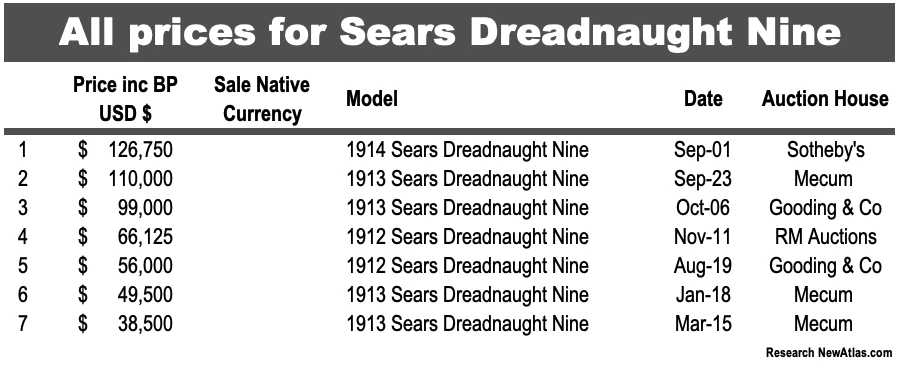
The price record for the Dreadnought model at auction is erratic, perhaps because its unique history and rarity is not well known. The highest price of $126,750 paid for a Sears Dreadnought was set by Sotheby's at a 2001 Chicago auction, and it was at that time, the highest amount that had ever been paid for a motorcycle.
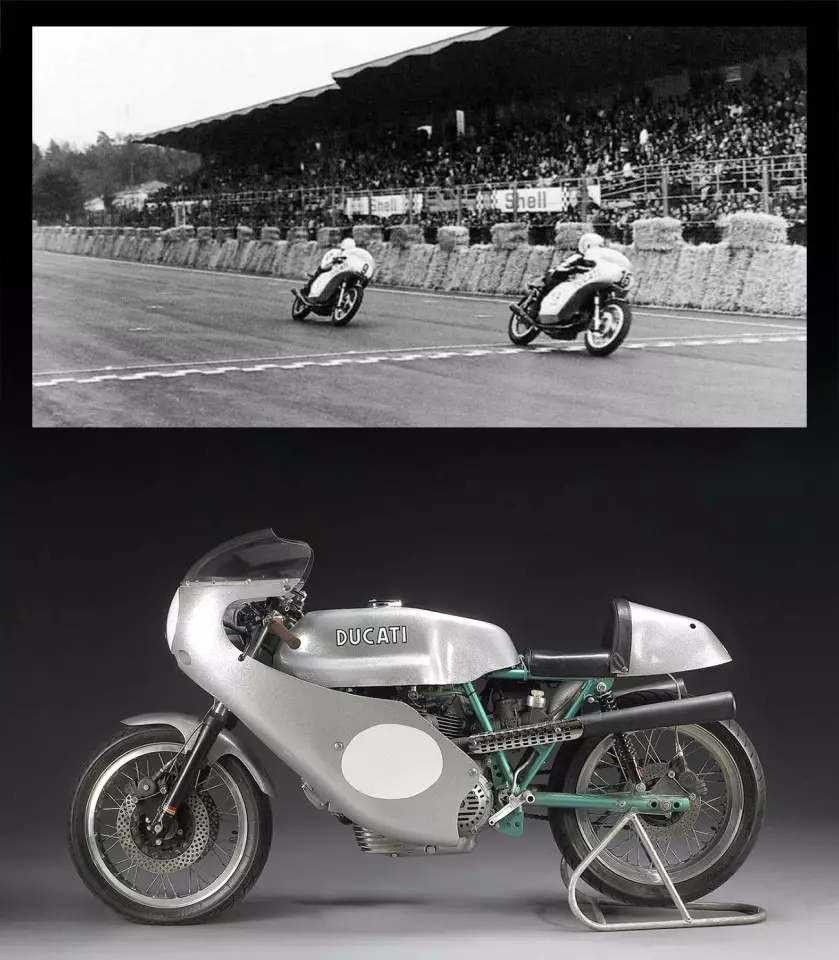
Phil Schilling is one of the all-time-great motorcycle writers and he wrote the story of that auction in the world's leading motorcycle magazine of that time - Cycle World - under the headline $100,000 Ducati. From Schilling's wonderful article: Without that Smart-Spaggiari 1-2 victory at the highest profile European race in 1972, everything would have been different for Ducati. There would have been no rebirth of the desmodromic legend, no 750cc V-Twin bevel-drive desmo, no aura and luster to the Ducati name. Ducati would likely have faded away slowly, remembered for its brilliant bikes of the Fifties and, in its declining years, for its wonderful spring-valve, bevel-drive V-Twin GT-750. Even with the incandescent glow from its 1972 Imola triumph and subsequent desmo sportbikes, Ducati barely weathered the Seventies and Eighties. The total production of all Ducati bevel-drive Twins amounted to a mere 30,000 units. So Imola ’72 provided the razor-thin margin for survival.
In retrospect, the Ducati was a bargain. If it were to go to auction again in 2023, it would almost certainly become the world's first million dollar motorcycle, and although it was an unfeasibly large sum for a motorcycle at that time, subsequent auction results show that people are prepared to pay up to twice as much money for bikes that are replicas of the original.
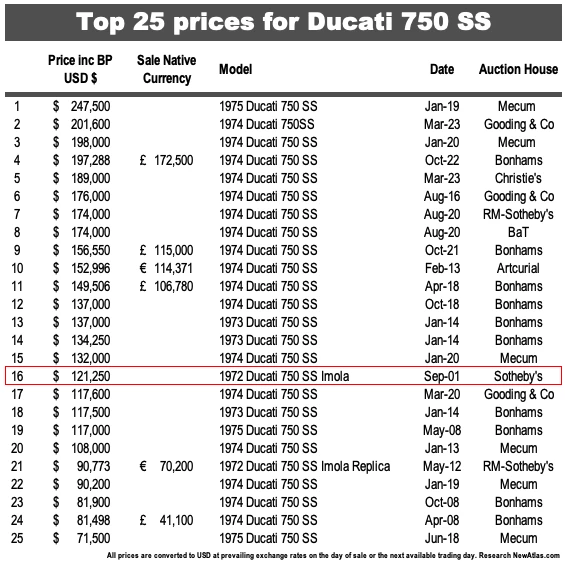
Conversely, occasional bargains pop up regularly, such as a gem that was owned by Formula 1 World Champion Phil Hill for 34 years before fetching just $56,000 at Pebble Beach in 2019, a fully-sorted specimen that had completed the 2016 Cannonball Run for just $49,500, and a bike that almost slipped through the cracks at the EJ Cole Collection auction, selling for just $38,500 and not being in the 100 most valuable motorcycles sold during that event. In 14 years, it slipped from being the most valuable motorcycle in history, to outside the top 100 sales at a single auction.
1955 Vincent Black Prince - an aerodynamic Black Shadow

Final price (inc Buyers Premium): $110,000
Estimate: $60,000 - $72,000
Auction Date: Saturday 9 September 2023
National Motorcycle Museum Link
Auction Page Link
There are many anomalies in the auction world and the comparative low price of the Vincent Black Prince is one of them. In the final years of the fabled Vincent motorcycle marque (1954 and 1955), Phil Vincent produced his fully-enclosed “Series D” range, offering streamlining to improve rider comfort on his best-selling models.
These new and quite distinctive machines were named Victor (based on the 500cc Comet), Black Knight (based on the standard specification 1000cc v-twin Rapide) and Black Prince (based on the higher spec 1000cc v-twin Black Shadow). With Britain quickly becoming prosperous again in this period after the austerity induced by WW2 , and the population's aspirations moving from motorcycles to cars, the decline in Vincent's motorcycle sales continued.
Hence although the Black Prince was an aerodynamic version of the world’s fastest roadgoing motorcycle (the Black Shadow), demand was low and just 132 were produced before Vincent motorcycle production ceased entirely in December 1955. Even with scarcity in the equation, a Vincent Black Knight has never sold for more than $164,500, which is a long way short of the heights at auction that its unfaired Black Shadow ($231,000), White Shadow ($434,000) and Black Lightning ($929,000) brethren have achieved. When restored, it is one of the most visually arresting motorcycles on the planet, yet it has the lowest model price record of any Vincent v-twin, including both pre- and post-WW2 Rapides. The rare pre-WW2 Rapide (£275,900 / $417,000) could reasonably be expected to have a higher value, but the not-so-rare post-WW2 Rapide record is marginally higher at $167,500 and even the Vincent 500cc Victor Series D has sold for a higher price (£107,100 / $176,736).
Given the esteem of the Vincent name, it isn’t surprising that there were several other Vincents in the collection, and they all sold at bargain prices: a 1952 Vincent Black Shadow for $93,500, a 1952 Vincent Rapide for $66,000, a 1952 Vincent Rapide for $48,400 and a 1954 Vincent Rapide for $44,000. Bear in mind that these were museum quality motorcycles.
1906 Crouch Model 154 demonstrates the Steve McQueen factor once more

Final price (inc Buyers Premium): $99,000
Estimate: $100,000 - $135,000
Auction Date: Friday 8 September 2023
National Motorcycle Museum Link
Auction Page Link
This bike is one of the many single cylinder motorcycles produced by the many manufacturers operating in the USA during the first decade of the 20th Century. Technologically and mechanically, it isn't anything special for the period, with its greatest claim to fame being that it was once part of the Steve McQueen Collection and was sold with authenticating paperwork at the original McQueen Estate sale in Las Vegas in 1988.
1915 Flying Merkel Twin

Final price (inc Buyers Premium): $82,500
Estimate: $100,000 - $120,000
Auction Date: Saturday 9 September 2023
National Motorcycle Museum Link
Auction Page Link
This remarkable 1915 Flying Merkel Model 575 V-twin is 108-years-old and seemingly original in every respect. The marque record at auction was set by an original 1911 Flying Merkel 1000cc v-twin Board Track Racer at $423,500 at the EJ Cole Collection sale in 2015, though there have been plenty of high prices for similar roadgoing 61ci Flying Merkel V-twins with sales of $192,500 in 2015, $176,000 in 2019 and $168,184 (£104,540) in 2015. There are three recent auction results for similar roadgoing V-twin Flying Merkels where the bids topped $100,000 ($120,000, $120,000 and $100,000) but failed to make reserve. Hence, this bike was an absolute bargain at $82,500 including buyers premium, particularly given its patina.
1909 Reading Standard X1-02

Final price (inc Buyers Premium): $66,000
Estimate: $35,000 - $42,000
Auction Date: Saturday 9 September 2023
National Motorcycle Museum Link
Auction Page Link
Reading Standard began building motorcycles in 1903 and ceased production approximately years ago. In the first decade of the last century, Reading Standard looked equally as capable as Indian, Harley-Davidson or Flying Merkel, developing its own side-valve engine and creating the first side-valve v-twin at a time when most makers still employed inlet-over-exhaust designs. This bike is such a machine and is beyond rare. Indeed, we cannot find another of this model that has ever been to auction before.
The marque was a favourite of EJ Cole, with several Reading Standard v-twins selling during the EJ Cole Collection sale in 2015, including a 1915 V-twin for $85,250, a 1913 V-twin for $82,500, another 1913 V-twin for $61,600, plus another three or four less sought-after models.
The "Easy Rider" "Captain America" and "Billy Bike" Replicas

Captain America Replica Final price (inc. BP): $60,500
Estimate: $35,000 - $42,000
Auction Date: Saturday 9 September 2023
National Motorcycle Museum Link
Auction Page Link
The 1969 movie Easy Rider resonated with the essence of a generation, and it played an outsized role in popular culture. As a motorcycle movie, it is a logical exhibit for any motorcycle museum to have replicas of the two key Panhead Harleys in the movie, but the relationship between these bikes and the National Motorcycle Museum is far deeper than simply paying homage to a cultural icon.
John Parham and hence the National Motorcycle Museum, recognised the cultural value of the Captain America Panhead Chopper (ridden in the movie by Peter Fonda as Wyatt) well before any other institution or individual. Parham owned the key motorcycle in that complex web for many years, and had it on display in the museum for a lengthy period prior to selling it to Los Angeles Movie Memorabilia collector Michael Eisenberg in early 2014. Eisenberg “flipped” the bike, sending it to auction at Movie Memorabilia auction house Profiles in History (now Heritage Auctions) in October, 2014. The bike elicited the highest bid ever made at auction for a motorcycle of $1.35 million - that’s US$1.5 million including the buyers premium.
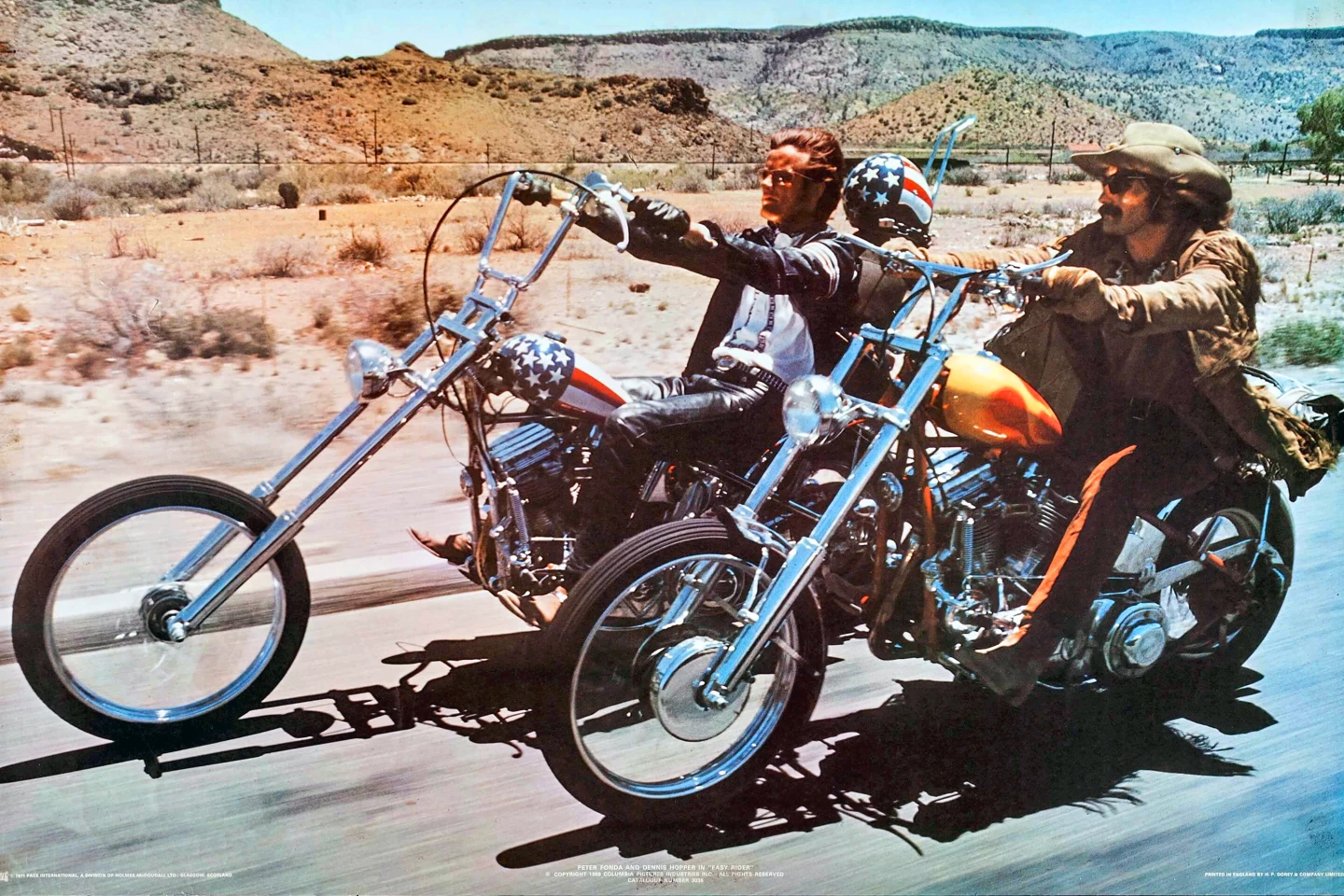
The sale is reported to have fallen through afterwards, though the Guinness Book of World Records still recognizes the sale, and Heritage Auctions (which subsequently purchased "Profiles in History") still lists it as a legitimate sale with a price of $1.5 million.
Unquestionably the world’s most recognizable and most valuable motorcycle, the Captain America chopper has been plagued by a series of cruel mishaps, not just in the film, but seemingly ever since. In the immediate aftermath of the film’s production, all of the intact bikes (both bikes used in the film by Dennis Hopper as Billy and the remaining intact Captain America bike ridden by Peter Fonda as Wyatt) were stolen at gunpoint just as shooting finished and have never been seen again. Like most Harley-Davidsons that drop off the register, they have most likely been broken into spare parts.
Then Dan Haggerty, who built the original movie bikes, was found to have built another “Captain America” bike and … so much mistruth has been spouted by so many of the eye-witnesses to what took place, that no-one is even sure if the bikes were stolen at gunpoint or not.
Anyway, the National Motorcycle Museum replicas of the iconic motorcycles from the 1969 film "Easy Rider" sold for $60,500 and $24,200, respectively.
1903 Indian Camelback

Final price (inc Buyers Premium): $57,200
Estimate: $150,000 - $180,000
Auction Date: Saturday 9 September 2023
National Motorcycle Museum Link
Auction Page Link
George Hendee’s bicycle factory—the Hendee Manufacturing Company—was established in 1889, and a fortuitous meeting with engine designer Oscar Hedstrom in 1900 was the start of a new direction for the factory. In 1901, a few prototype Indian “motocycles” were built, with true production commencing in 1902, with 143 machines built. The first full run of production began in 1903, and 376 machines built that year, with engine numbers commencing at 244. With an engine number of 358, this bike is one of the earliest Indians known, so someone got a spectacular buy with this bike, picking it up for a third of the estimate.
The auction record for this model is actually $209,000, fetched by an original paint 1903 model in 2017. Some other prices of Camelback Indians highlight the value of the model at auction with a 1903 Indian selling for $143,000 in 2021, a 1901 Indian Camelback selling for $133,500 in 2011, a 1906 Indian Camelback once owned by E. Paul duPont fetching $115,500 in 2015, and a 1905 Indian Camelback selling for $104,500 in 2019.
At this auction a 1907 Indian Camelback with an estimated price of $65,000 to $78,000, sold for $55,000, emphasising the extent of the bargains.
1985 Roth Ed ‘Big Daddy’ Roth's "Asphalt Angel" Custom Trike

Final price (inc Buyers Premium): $55,000
Estimate: $40,000 - $48,000
Auction Date: Friday 8 September 2023
National Motorcycle Museum Link
Auction Page Link
Ed "Big Daddy" Roth was an American artist, cartoonist, illustrator, pinstriper and custom car designer and builder who created the hot rod icon Rat Fink and other characters. Roth was a key figure in Southern California's Kustom Kulture and hot rod movement of the late 1950s and 1960s. This Buick V6-engined trike is just one of the
The "Dragon Bike" from the movie "Wild Angels"

High Bid (not sold): $50,000 (passed in)
Estimate: $100,000 - $120,000
Auction Date: Saturday 9 September 2023
National Motorcycle Museum Link
Auction Page Link
If bikes could "name drop", this bike would have a cast of thousands. It's a 74 CI Panhead chopper constructed for the 1966 film "Wild Angels" and the dragon on the tank is Von Dutch artwork, and it was offered with authentication by Mil Blair, co-founder of Easyrider magazine, which chronicled the evolution of chopper culture. The movie starred Peter Fonda and Nancy Sinatra, it was ridden by Peter Fonda in the movie and ... if you feel like some sort of culture-devoid numpty who had never heard of the movie and can't see what all the fuss is about, you are not alone.

When I saw that the Vintagent (which I rate highly) had named it as one of the top 10 most important bikes in the sale, I did some exploration and although Wild Angels was unquestionably a precursor to Easy Rider, everything I could find on The Wild Angels was totally cringeworthy, and more akin to Reefer Madness than Easy Rider. This is a bike for a chopper culture aficionado, and the expectations of the seller were such a long way from the perceptions of the buyers that some serious brain recalibration may be required if it is to find a new home.
Harley-Davidson Billboard

Final price (inc Buyers Premium): $41,300
Estimate: NA
Auction Date: Saturday 9 September 2023
National Motorcycle Museum (No Link)
Auction Page Link
In remarkable condition considering it is clearly in the vicinity of 100 years old, no doubt this beautiful artifact of history will become visible elsewhere. Let us know when it goes on display and we'll make a notation here.
1911 Steco Engineering Aerohydroplane

Final price (inc Buyers Premium): $33,000
Estimate: $50,000 - $60,000
Auction Date: Saturday 9 September 2023
National Motorcycle Museum Link
Auction Page Link
What is a sea plane doing in a motorcycle museum? Well, the beginnings of the motorcycle industry and the aviation industry required almost identical skill and mind sets, with ingenuity, resilience, a high tolerance to uncertainty, and the ability to produce reliable lightweight and powerful engines being foremost. Not surprisingly, many of the early innovators in the aviation industry already produced terrestrial transport and Ralph Stephens’ Steco Company produced this circa 1910 Aerohydroplane and it also produced cyclecars. The Aerohydroplane retains most of its original 110-year-old fabric covering, and is one the oldest unrestored aircraft in the world, even if its final price did not reflect its significance. Cyclecars are the point on the transportation family tree where cars and motorcycles diverged, and a 1914 Steco Cycle Car was also part of the auction, fetching a very modest $6,600.
1957 Rikuo RQ 750 - The Japanese Harley

Final price (inc Buyers Premium): $31,900
Estimate: $20,000 - $24,000
Auction Date: Saturday 9 September 2023
National Motorcycle Museum Link
Auction Page Link
A combination of pre-WW2 British tarrifs on American motorcycles plus the drop in sales resultant from the Great Depression saw Harley Davidson license the production of its 750 V-twins to Japanese company Rikuo (meaning “Road King”), which subsequently enlarged the engine capacity to 1000cc and eventually 1200cc. Around 18,000 Rikuo faux-Harley-Davidsons were produced before production ceased in 1962, by which time the company had been purchased by Japanese company Showa. Showa is best known as a car and motorcycle suspension company and the relationship has been maintained as it is now an OEM supplier to Harley Davidson. This bike is so rare that we can find only two that have ever been to auction before ... and this bike appears to now own the world record price.
1965 Wild Bill Gelbke RoaDog

Final price (inc Buyers Premium): $22,000
Estimate: $50,000 - $60,000
Auction Date: Saturday 9 September 2023
National Motorcycle Museum Link
Auction Page Link
Auction provenance comes in many forms, with objects owned, used, worn or created by famous people, or appearing in famous movies, TV shows, video clips or historic moments often selling for 100s of times their worth without that moment in time. This bike is none of those things, but prior to a bit of research, I thought it might sell for an extraordinary amount of money.
The bike has few claims to fame other than being so unfeasibly large that it defies logic. In the mid-sixties, a newspaper photographer named Ralph Goldsmith took a pic in a parking lot of a guy on a preposterously large motorcycle that propagates onto posters and then onto the bedroom walls of a significant percentage of the baby boomer generation. Just one image made this motorcycle the stuff of legend.
Indeed, there would be few American boomers that don’t recognise the single image, and hardly anybody, perhaps no-one, who knows the real story behind it. There's now a juicy story that has been partially told, with the builder of the bike being shot dead by police and lots of intrigue about drug running and ... but no-one appears to really know and little that can be authenticated.
Whatsmore, despite everyone trying really hard not to say it, this is not the original Roadog in the poster.
Apparently Wild Bill built TWO roadogs and this was his second identical motorcycle, built on request for someone who liked the first one.
In 2003, two decades ago, someone else got caught out by the same assumption that no-one would build two of something like this.
Now it is pretty close to the original, and built by the same guy, but according to the laws of auction-recognised provenance, which seem to contradict Marquis of Queensbury Rules, this bike is only worth $22,000.
1962 Victoria 155
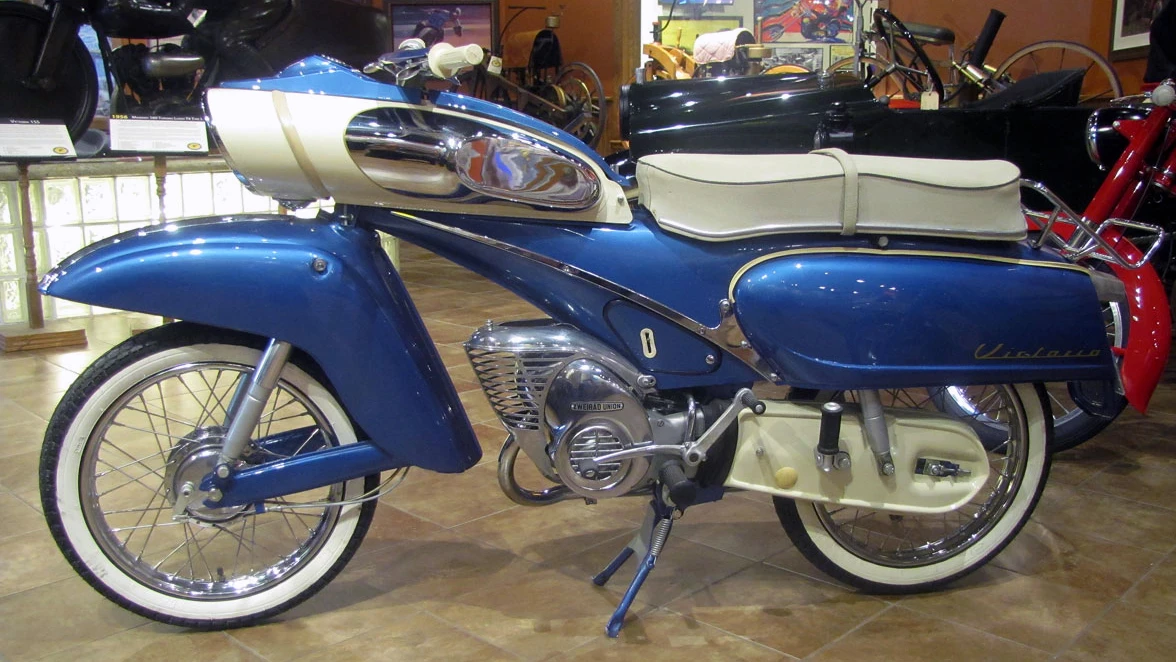
Final price (inc Buyers Premium): $19,800
Estimate: $15,000 - $18,000
Auction Date: Friday 8 September 2023
National Motorcycle Museum Link
Auction Page Link
One of the many wonderful eccentricities of motorcycle design across the last 130 years, this bike has a pressed-steel body, an integral fuel tank (with the headlight) and a three-speed gearbox. Contrary to the auction and museum information, this Victoria 155 motorcycle is not 155cc, but an even more humble 50cc, which makes it one of those rare collectible motorcycles that is not a hairy “he man” icon but revered just for its design and beauty and ... yes, eccentricity captures it.
Having a motor that displaces just 50cc normally makes a motorcycle near invisible to the collector community, and there are only two 50cc two-wheelers that regularly appear in auction listings above the $20,000 mark: this bike and Honda’s exquisite 1998 Dream 50, a modern homage to Honda’s tiny 1950s race bikes created on the company’s 50th birthday.
The Victoria 155 is even rarer, because it is a two-stroke, and two-strokes that aren’t associated with Steve McQueen or haven’t won a world championship just don’t command much money at auction. They smell, rattle, make unmanly sounds and are only tolerated because they make lots of horsepower. This creature doesn't even do that.
The bike is a well kept secret because it was released in Germany under three different brand names as the DKW Hummel (Bumblebee), the Express Kavalier (Cavalier), and the Victoria Spoetnik (named after “Sputnik 1”, the first artificial Earth satellite), and it goes to auction under every permutation and combination of all of those words, often with a mixture of its nickname, which is “the tin banana.”
Wait, it gets worse, as the bike’s fan cooled motor is dreadfully unreliable, and given that it was a two-stroke produced before advances in metallurgy and understanding of the two-stroke’s peculiar wave-pulse strengths and weaknesses became understood, the 115 model had just 2 hp and a top speed of 25 mph. The155 deluxe model had the same motor with slightly different porting giving it a narrow powerband, 3.7 hp, a top speed of 40 mph downhill with a tail wind, a high beam (and switch) for the headlight, and a horn. Luxury indeed!
As gorgeous as the Tin Banana is, those who have owned one found it to be an apparent nightmare to maintain and work on, with even a spark plug change requiring a workshop and a goodly amount of effort, which is a distinct disadvantage for a 50cc two-stroke with prehistoric ignition. Though the beauty may only be skin deep, the Zweirad Union 115 and 155 models are highly sought after in America, where the model record stands at $29,700, but you’ll also find many others that have sold for implausible amounts if you scour the auction listings and try different combinations of all those words: $26,400, $24,200, $23,100, $22,000, and $22,000, f’rinstance. Hence, although this 50cc beauty contest winner isn't as fast as a bicycle, and still sold for an eye-watering sum, it was still a bargain.
1867 Roper Steam Cycle Replica

Final price (inc Buyers Premium): $11,000
Estimate: $10,000 - $12,000
Auction Date: Friday 8 September 2023
National Motorcycle Museum Link
Auction Page Link
Developed independently of each other, two steam-powered machines (one from France and one from America) are arguably the world's first motorcycles. The American contender is the1867 Roper Steam Velocipede, built by Sylvester Roper of Massachusetts in the period 1867 to 1869. The bike has a forged iron frame and wooden wheels, with the saddle seated atop the water tank for the boiler. The original machine is near priceless, and now resides in the National Museum of American History at the Smithsonian, and the bike sold by Mecum on 8 September is a very faithful replica of that original.
The steam-powered Michaux-Perreaux appeared at roughly the same time as the Roper (between 1867 and 1869), but Roper never patented his work whereas Louis-Guillaume Perreaux patented his steam velocipede on December 26, 1869. It's all academic, because they operated independently anyway and solved the same equation of functional powered two-wheel transport with the same steam power source, but arranged different ways. They are both perfect examples of humanity's ingenuity at its finest.
Roper built a second steam-powered motorcycle in 1895 and that machine went to auction in 2011, where it failed to meet reserve and was passed in with a high bid of $425,000. It was expected to become the first motorcycle to sell for more than $1.0 million at the time, so those numbers offer some perspective on the value of the first bike from the 1860s, of which the sale bike is a replica. Getting access to the original in order to build a perfect replica would most likely prove insurmountably problematic, and the cost of building a replica with all the right metallurgy ad infinitum would probably cost hundreds of thousands of dollars. So the $11,000 final price for this lot was a bargain indeed.




